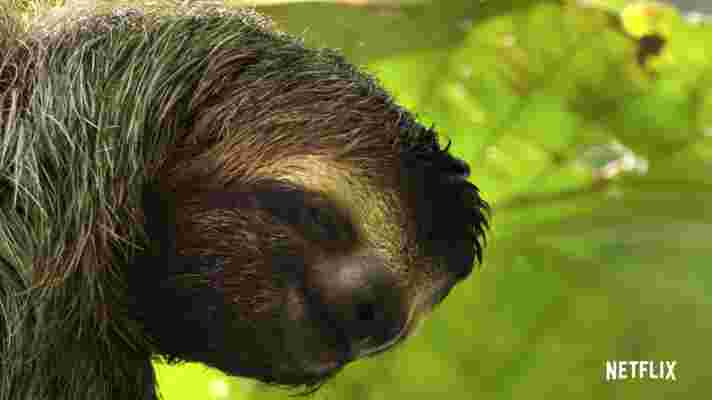
Is Barack Obama TV's successor to David Attenborough? Netflix is banking on it
by
Tomasz David
Barack Obama, former president of the United States of America, is the unlikely narrator of a new Netflix wildlife documentary series – and it might be the most inspired bit of casting that the streaming giant has made in a while.
Our Great National Parks, which makes its Netflix TV show debut on April 13, will see Obama discussing the wonders of protected wilderness spaces across the globe and the animal inhabitants they contain. Monterey Bay in California, Tsavo National Park in Kenya, and the rainforests of Gunung Leuser National Park in Indonesia are all set to feature. Oh, and some sloths:

Who doesn’t love a good sloth?
You can check out the first trailer below:
“A fish that can walk. Surfing hippos that want to catch the waves. Species found nowhere else on earth,” says Obama. “When humanity started to protect these wild places, we did not realize how important they would become: They’re a haven for endangered species, and a hotbed for scientific research.”
A trusted voice – and natural Attenborough successor?
The five-part series was first announced in February 2021, and was part of a slew of programming Netflix signed from Barack and Michelle Obama’s production company Higher Ground Productions.
It’s already proved a successful partnership between the two companies, bearing fruit in the shape of kids shows Ada Twist, Scientist, and Waffles + Mochi. The Oscar-winning documentary American Factory, Michelle Obama’s memoir adaptation Becoming, and the award winning Crip Camp: A Disability Revolution, are also part of the Obama family's back catalog.
But the move to make Obama a spokesperson for the natural world is a delightful one.
There’s no arguing against who the king of television is when it comes to the natural world. That’s British naturalist David Attenborough, who has done more over the decades to educate the world on the delights and plights of the animals across the globe, and the danger their habitats are in. Starting his broadcasting career with the BBC, Attenborough has also recently developed (and featured in) shows for the likes of Sky and Netflix.
After a phenomenal career (that shows no signs of slowing, to be fair), a successor to the 95 year old Attenborough would be a great win for any network – not to mention a world of animal enthusiasts looking to learn how best to protect our planet’s co-inhabitants.
Obama is a natural choice – at least, for a streaming giant like Netflix. The former president may not have the zoological experience of Attenborough, but he’s a trusted public figure. His Green New Deal was only partially successful, too, but was a step in the right direction for awareness surrounding climate change and humanity's environmental impact. Our Great National Parks even shares an executive producer from Attenborough’s Blue Planet II, so viewers will know it's in good hands from a production standpoint. He’s also got a great voice perfect for placing over awe-inspiring footage of nature. In our view, Netflix could do worse than to install Obama as its long-term Attenborough replacement.
So, you love your shiny new fitness tracker and you want to start monitoring your slumber – but how does sleep tracking really work?
Sleep tracking has become big news in recent years. With roughly one in three of us using a wearables these days – whether it’s a fully-featured smartwatch like the Apple Watch 7 or the Samsung Galaxy Watch 4 , or a more straightforward fitness tracker such as the Fitbit Inspire 2 or Huawei Band 5 – it means more of us are tracking our health in various different ways.
In addition to tracking our fitness and activity levels, most of these devices can also monitor the amount of sleep we’re getting every night by monitoring our heart rate and movements to determine the stage of sleep we might be in.
The four stages of sleep
There are four main stages of sleep, which together make up a single cycle of around 90 minutes. During each of these stages our body movements and heart rates differ.
“Stage one is short, only lasting between five and 10 minutes,” explains Rob Hobson, registered nutritionist and author of The Art of Sleeping. “During this stage, sleep is shallow and you can be easily woken.”
“Stage two, or light sleep, is characterized by a slowing down of both breathing and heart rate, and makes up about half of the time you spend asleep.”
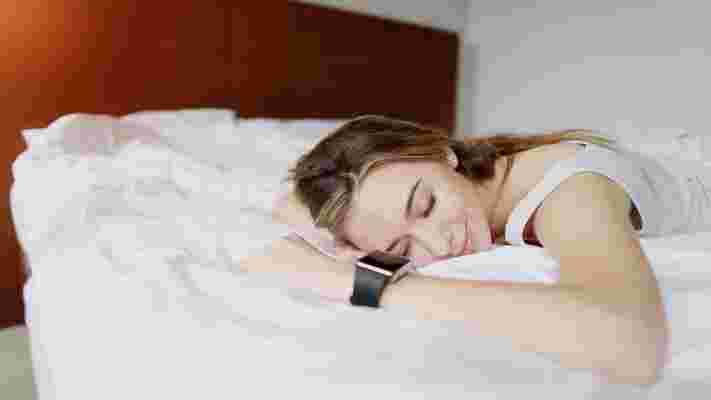
Stage three is deep sleep, when your body totally relaxes and your pulse and breathing rate drop even further.
“This stage is restorative and essential for recovery and growth, as well as bolstering the immune system,” says Hobson.
The final stage is REM, where your body is inactive but your eyes move rapidly. During this stage our heart rate increases, and breathing becomes more irregular.
“Bodily functions such as protein synthesis peak now,” says Hobson. “This is also the point when you are most likely to dream. This stage is considered to be essential for cognition, learning and creativity.”
How does sleep tracking work?
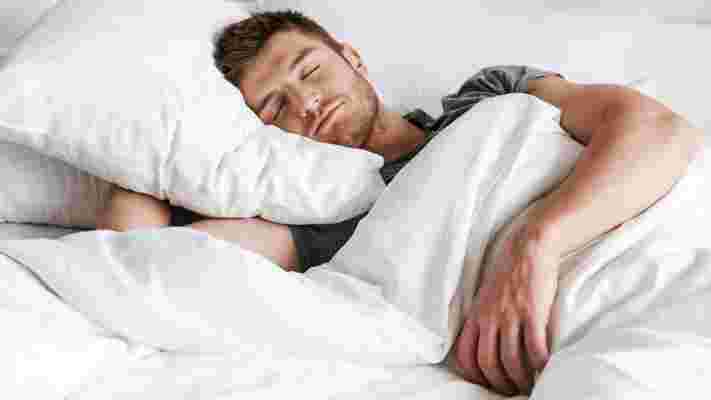
Sleep trackers monitor our sleep by measuring our movements and heart rate, which both correspond to our sleep pattern. While early trackers simply monitored movements, they now deploy much more sophisticated technology.
“Data using just our movement was often unreliable because, of course, a person could be lying still, but very much awake,” explains Will Turner, co-founder of team-focused fitness app GoJoe.
“But new technologies have emerged which, when used in conjunction with movement data, make this tracking more reliable. The main way this is achieved is through photoplethysmography (or PPG) – the blood underneath the skin reflects the red light emitted by your smart watch, and absorbs the green light. Each heartbeat allows more absorption of green light and, in between heartbeats, less green light can be absorbed, meaning your device can track your heart rate alongside your movement data and work out when you’ve been asleep.”
“Some devices also use ‘pulse oximetry’, which also analyses the level of oxygen saturation in your blood. This feature, generally recognised as being more reliable than the ‘red light, green light’ method, uses a combination of red and infrared sensors which respond differently to blood that is more or less oxygenated. Highly oxygenated blood absorbs more infrared light and allows a lesser proportion of red light to reflect back, allowing your device to analyse your sleep.”
Your blood oxygen levels will dip slightly when you sleep, as your breath rate decreases. So in theory your tracker should be able to monitor your blood oxygen levels and use this information to confirm you’re asleep.
Can sleep trackers improve sleep?
Currently the jury is out on this – not least because sleep is different for everyone, but also because many experts believe tracking sleep could be doing more harm than good for some.
“While it is great to see people becoming more aware of sleep, and their own sleeping habits, in some cases it’s causing unnecessary worry and concern,” explains Lisa Artis from The Sleep Charity.
“There is even a term for it: orthosomnia. Orthosomnia describes people who obsess over the results of their sleep and fitness trackers. Unfortunately, unlike eating five portions of fruit and veg or exercising daily, you often can’t control whether you sleep for eight hours. And if people start putting pressure on themselves to sleep better, the likelihood is they won’t.”
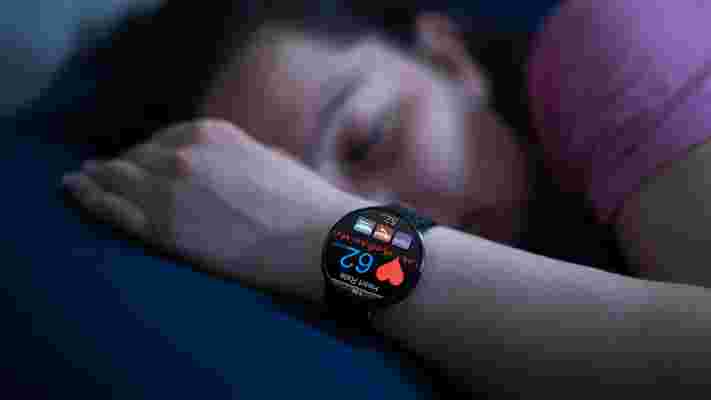
How accurate are sleep trackers?
The answer is, unfortunately, questionable.
“There are a few studies comparing the accuracy of sleep monitoring devices against recognised lab testing called polysomnography, which looks at brain waves, blood oxygen levels, heart rate, breathing and eye and leg movements,” Hobson says.
“A comprehensive study published in the journal Sleep Medical Reviews found that sleep trackers were only accurate 78% of the time when identifying sleep versus wakefulness. This accuracy dropped to just 38% when estimating how long it took a participant to fall asleep”
One major hurdle is that people don’t necessarily understand how to interpret the data from their devices – which means there’s little point in getting it. “As with most things – nutrition, breathing, mindfulness – there is never one size fits all,” adds Hobson. “These apps use algorithms which need to follow a set way of working, so the apps are never going to be as effective as seeing a proper professional if you need real help.”
How to improve your sleep
Whether you decide to track your sleep or not, there are some simple steps you can take to improve your sleep.
“If you’re obsessing over the tech, stop using it,’ advises Artis. “Instead, put some good sleep hygiene principles into practice – having a regular sleep pattern, winding down sufficiently before bed, avoiding caffeine and alcohol, creating the right calming bedroom environment, etc. Remember, the best way to gauge how well you are sleeping is to listen to your body and assess how you feel the next day.”
Do you nap throughout the day and never seem to have energy to really get going? Or is your sleep tracker telling you that you didn't get much quality sleep again last night? If so, it may be time to incorporate some foods that help you sleep into your daily meal plan. Not only will these supercharge your snooze so that you'll feel better rested and more energetic in the day, they're super-tasty.
As we'll discover shortly, if you're not getting good quality sleep you're more likely to make unhealthy food choices. Luckily, help is at hand in the form of Rob Hobson (RNutr, SENR), a leading London-based nutritionist and author of The Art of Sleeping.
Hobson recently partnered with British Apples & Pears to create the Happy Apple Plan for healthy digestion, and here he shares his expert advice on how specific drinks and foods affect sleep. And, as an exclusive for TechRadar readers, Robson has created a daily meal plan using foods that help you sleep better at night. Here's what he had to say...
The best foods that help you sleep
Trytophan-rich foods To help you fall asleep easier at night, Hobson recommends eating foods rich in Tryptophan, an amino acid: "It's required to make melatonin in the brain, which is the hormone that helps to make you feel drowsy and ready for sleep.
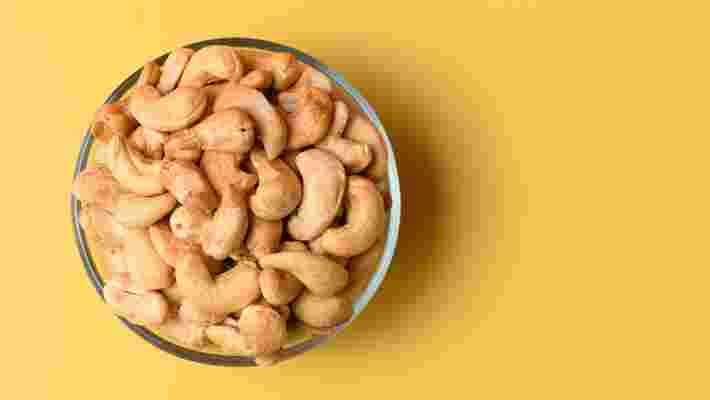
"This amino acid has a lot of competition to make it across the blood brain barrier, but including foods rich in carbohydrates, such as pasta, rice and potatoes, can increase its uptake." Hobson explains.
"These foods elevate the hormone insulin, which helps the uptake of tryptophan in several ways, such as reducing the levels of other amino acids that compete with it for transport carriers to the brain."
However, as Tryptophan isn't naturally produced by the human body, you need to get it from food. Hobson recommends the following tryptophan-rich foods to help you better sleep:
Valerian Hobson is also a fan of valerian, a herbal remedy and natural sleep aid typically used to reduce stress and help induce sleep due to its sedative effects. "The sedative effect of valerian is due to the inhibition of enzymes that break down an inhibitory brain chemical called GABA, Gamma- Aminobutyric acid.
"As GABA levels rise it dampens down the over-stimulation that can cause anxiety-driven thoughts that stop you sleeping." Hobson explains. You can find valerian supplements in capsule or tea form.
The worst drinks and foods for sleep
On the flip side, what you're consuming throughout the day may be creating a barrier between you and better sleep. If you find yourself tossing and turning most nights, Hobson recommends avoiding the following foods and drinks:
Caffeine A lot of people rely on caffeine in coffee, tea and soft drinks to help them feel alert, but, as Hobson explains, not everyone has the same reaction to this stimulant: "Caffeine can remain in the body for three to five hours, but in some people the effects can still be seen 12 hours after consumption.
"Not everyone has the same reaction to caffeine, though, and this is down to a gene called CYP1A2 that controls the enzyme determining how fast you metabolise it. If you’re lucky enough to have the fast variant of the gene, you metabolise caffeine four times faster than those with the slow variant."
Hobson says if you can't quit caffeine outright, only consume it first thing in the morning. Otherwise, if you need a midday boost, Hobson recommends caffeine-free hot teas such as rooibos, ginger and lemon, or ginseng.
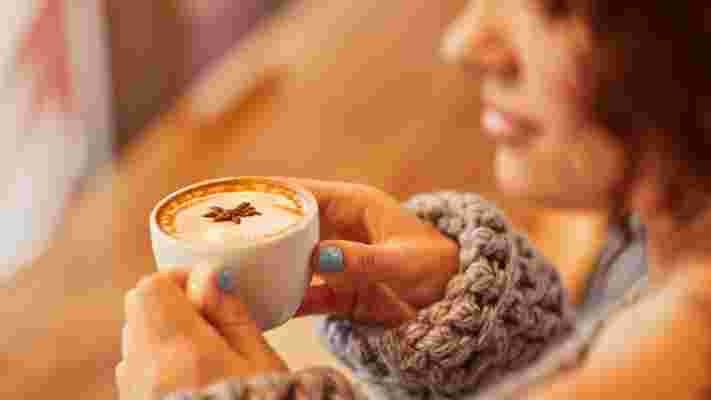
Alcohol As we recently discovered when interviewing two experts about alcohol and sleep , even small amounts of booze can affect your quality of sleep. "While a seemingly harmless nightcap might be relaxing at first, it can have rebound effects," cautions Hobson, "causing you to wake up during the night due to dehydration or the need to visit the bathroom, and in some cases it can also contribute to heartburn.
"Alcohol can also impair the restorative part of the sleep cycle, REM, as well as interfering with the flow of calcium into nerve cells, affecting the region of the brain that controls sleep function."
Spicy foods Drinks aren't the only things to blame for your sub-par snooze. Spicy foods may cause or worsen heartburn for individuals prone to indigestion. "They can also trigger hot flashes during the menopause which doesn’t help with sleep."
A meal plan that helps you sleep better
Want to use your daily diet to supercharge your sleep but aren't sure where to begin? Especially for TechRadar readers, Hobson has developed a simple, healthful plan focused on foods that help you sleep, and to improve the quality of your shut-eye. Here's what he suggests:
Breakfast: Oats topped with sliced apple and sultanas "This is a great way to start the day," says Hobson. "Apples in particular have several properties that increase feelings of fullness, being packed with fibre and containing up to 86% water content. This will help to aid weight loss and curb hunger so you can achieve those health targets."
As for oats, they are, "a good source of B vitamins and magnesium which help the body to make melatonin (sleep hormone). Keeping your energy levels up with high fibre carbs such as oats can also help to prevent energy slumps which could have you tempted to nap and this is not a good option if you have trouble sleeping."
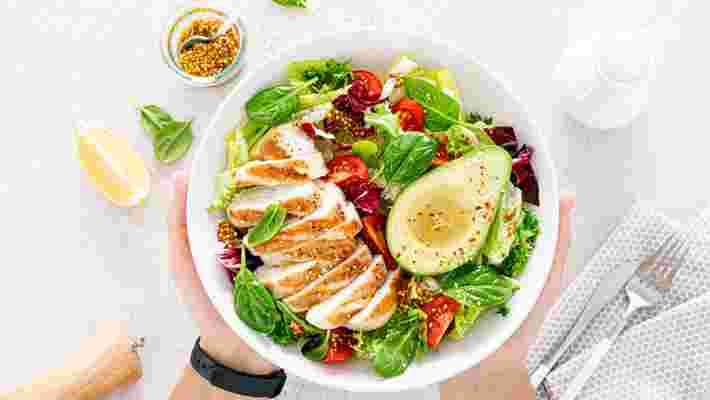
Lunch: Chicken salad "Protein is a good option for lunch, especially if you struggle with mid-afternoon energy slumps, which are more amplified if you haven’t slept well," Hobson explains. A lean protein like chicken keeps your energy levels up while also helping your body make melatonin thanks to the tryptophan.
Dinner: Pasta or rice with grilled meat/fish/tofu and veggies "This combination provides a good source of tryptophan and then carbs." The protein – meat, fish or tofu – contains the tryptophan your body requires to produce melatonin. The pasta or rice are the carbohydrates that'll help increase insulin levels so your body can absorb the tryptophan better.
Healthy eating benefits your sleep and wellbeing
As one study suggests , a lack of quality sleep disrupts the endocannabinoid (eCB) system that controls our appetite. "The problem with sleep deprivation is that it can lead to unhealthy food choices for a variety of reasons," says Hobson.
"This includes a general lack of motivation to eat well due to fatigue and research has also suggested that a lack of sleep disrupts the hormones that control our appetite making us more hungry when we haven’t slept well."
"The Happy Apple Plan states that eating an apple before a meal can aid weight loss. The apple helps to increase the overall fibre content of the meal, and that means you feel full and satisfied for longer, preventing mindless snacking between meals.
Apples are also great for our gut, as Hobson explains: "Our diet has a significant impact on our gut microbiota and gut environment. Consuming an apple a day encourages the growth of more ‘friendly’ bacteria in the large bowel, essential for maintaining a healthy gut. Apples also contribute to more regular bowel movements because they are a good source of fibre, which is key to supporting digestion."
But this humble fruit isn't the only star of the show, with Hobson recommending the following healthy foods too: "Also choosing lean protein foods such as meat, fish, protein and legumes in the evening alongside carbs such as pasta and rice will help with sleep and all these foods are key to the med diet."
Don't forget that along with a healthy diet, what you sleep on can also impact your quality of shut-eye, so make sure you are sleeping on the best mattress for your body and budget, and a comfy pillow that suits your sleep style. If you're unsure, read our expert-lead feature on how to tell if you're sleeping on the wrong pillow .
Read more:
This article is part of TechRadar's Sleep Awareness Week 2022 celebration (running until Saturday 19 March), a week-long look at all things slumber. We'll be bringing you proven techniques and tips to help you sleep better, and have rounded-up all the top-rated tech to transform your sleep.
Leave a Comment